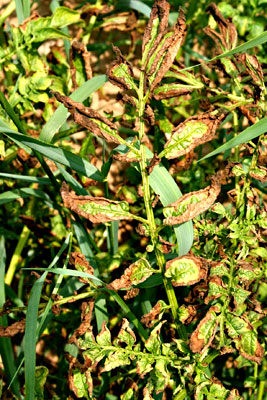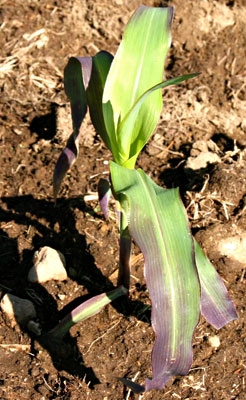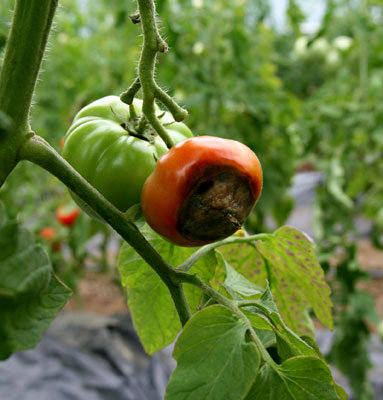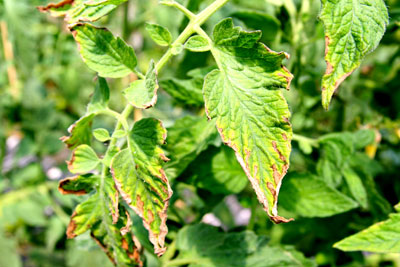 |
 |
| Leafhopper burn on potato foliage. Eric Sideman photo. | Phosphorus deficiency in corn. Eric Sideman photo. |
The Season is Beginning. Don’t Misdiagnose Your Problems.
By Eric Sideman, Ph.D.
This is a good time of year to study up on the biology and symptoms of problems that may later arise in your crops. Problems will arise, and misreading symptoms may interfere with easy solutions, may cause unnecessary pesticides applications, and may lead to years of unhappiness. So I am reviewing a few of the most common mistaken identifications that I get as questions. Remember, you can contact me about any gardening or farming problems you are having ([email protected]), and don’t be concerned about asking dumb questions. I have heard them all by now, and none are really dumb, just another opportunity to learn.
Hopperburn. I frequently get calls from folks who think it is late blight. Actually, although it looks like it, it is not a disease at all. These symptoms result from feeding by the potato leafhopper, a sucking insect that loves potatoes, beans and strawberries. See the June 23, 2011, issue of my Pest Report at www.mofga.org to learn more about this problem.
 |
| Blossom-end rot on tomato. Eric Sideman photo. |
 |
| Potassium deficiency in tomato. Eric Sideman photo. |
Blossom end rot. This, too, looks like a disease caused by a pathogen, but it is not. Blossom end rot is caused by a lack of calcium at the rapidly growing points in a plant, such as shoot tips or ends of fruit. Rarely is it caused by an actual calcium deficiency in the soil. Almost always, blossom end rot is caused by a lack of water during a period of fast plant growth. Because calcium is moved through the plant by water, this lack of transport during dry periods is seen at the growing points as a deficiency. See the July 17, 1999, issue of the Pest Report at www.mofga.org for details about this problem.
Phosphorus deficiency. This looks like a nutrient deficiency and it is – phosphorus deficiency in corn. Make sure you base your soil amendment applications on soil tests. If your soil test shows optimum levels of nutrients and you are still seeing symptoms of nutrient deficiency, then think of compounding problems. For example, phosphorus deficiency symptoms appear when plants were in soil that was too cold. Phosphorus may be sufficient in the soil, but plant roots were too cold to function well at absorbing it. Similarly, nitrogen deficiency symptoms can occur in plants in soils that are too wet or too low in pH.
Potassium deficiency. This problem is common in tomatoes grown in high tunnels. Tomatoes are pushed hard in high tunnels to produce vast amounts of fruit, which takes vast amounts of potassium. Mark Hutton, University of Maine Cooperative Extension vegetable specialist, recommends supplying potassium in a high tunnel at a rate of 200 pounds per acre. By the way, harvesting a good yield of tomatoes from an acre will remove about that much potassium from the field, so by adding 200 pounds per acre, you are only replacing what was removed.
Eric Sideman is MOFGA’s organic crop specialist. You can contact him with your questions at [email protected] or 568-4142.
